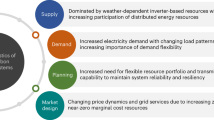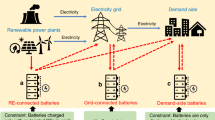Abstract
Long-duration energy storage (LDES) is a potential solution to intermittency in renewable energy generation. In this study we have evaluated the role of LDES in decarbonized electricity systems and identified the cost and efficiency performance necessary for LDES to substantially reduce electricity costs and displace firm low-carbon generation. Our findings show that energy storage capacity cost and discharge efficiency are the most important performance parameters. Charge/discharge capacity cost and charge efficiency play secondary roles. Energy capacity costs must be ≤US$20 kWh–1 to reduce electricity costs by ≥10%. With current electricity demand profiles, energy capacity costs must be ≤US$1 kWh–1 to fully displace all modelled firm low-carbon generation technologies. Electrification of end uses in a northern latitude context makes full displacement of firm generation more challenging and requires performance combinations unlikely to be feasible with known LDES technologies. Finally, LDES systems with the greatest impact on electricity cost and firm generation have storage durations exceeding 100 h.
This is a preview of subscription content, access via your institution
Access options
Access Nature and 54 other Nature Portfolio journals
Get Nature+, our best-value online-access subscription
$29.99 / 30 days
cancel any time
Subscribe to this journal
Receive 12 digital issues and online access to articles
$119.00 per year
only $9.92 per issue
Buy this article
- Purchase on Springer Link
- Instant access to full article PDF
Prices may be subject to local taxes which are calculated during checkout





Similar content being viewed by others
Data availability
The data that support the figures and other findings of the study are available from the corresponding author upon reasonable request given the size of the data sets generated for this research. Input data and sources can be found in the Supplementary Information.
Code availability
The code used to generate and analyse the data that support the findings of this study are available from the corresponding author upon reasonable request. The CEM model ‘GenX’ used in this research is being prepared for open-source release.
References
Sepulveda, N. A., Jenkins, J. D., de Sisternes, F. J. & Lester, R. K. The role of firm low-carbon electricity resources in deep decarbonization of power generation. Joule 2, 2403–2420 (2018).
Daggash, H. A. & Mac Dowell, N. Structural evolution of the UK electricity system in a below 2°C world. Joule 3, 1239–1251 (2019).
MacDonald, A. E. et al. Future cost-competitive electricity systems and their impact on US CO2 emissions. Nat. Clim. Change 6, 526–531 (2016).
Brown, P. R. & Botterud, A. The value of inter-regional coordination and transmission in decarbonizing the US electricity system. Joule http://www.sciencedirect.com/science/article/pii/S2542435120305572 (2020).
Victoria, M., Zhu, K., Brown, T., Andresen, G. B. & Greiner, M. The role of storage technologies throughout the decarbonisation of the sector-coupled European energy system. Energy Convers. Manag. 201, 111977 (2019).
Shaner, M. R., Davis, S. J., Lewis, N. S. & Caldeira, K. Geophysical constraints on the reliability of solar and wind power in the United States. Energy Environ. Sci. 11, 914–925 (2018).
Safaei, H. & Keith, D. W. How much bulk energy storage is needed to decarbonize electricity? Energy Environ. Sci. 8, 3409–3417 (2015).
Becker, S. et al. Features of a fully renewable US electricity system: optimized mixes of wind and solar PV and transmission grid extensions. Energy 72, 443–458 (2014).
Guerra, O. J. et al. The value of seasonal energy storage technologies for the integration of wind and solar power. Energy Environ. Sci. http://xlink.rsc.org/?DOI=D0EE00771D (2020).
Dowling, J. A. et al. Role of long-duration energy storage in variable renewable electricity systems. Joule 4, 1907–1928 (2020).
Lazard’s Levelized Cost of Storage Analysis–Version 6.0 (Lazard, 2020); https://www.lazard.com/media/451418/lazards-levelized-cost-of-storage-version-60.pdf (accessed 20 December 2020).
Tuttman, M. & Litzelman, S. Why Long-Duration Energy Storage Matters (ARPA-E, 2020); https://arpa-e.energy.gov/news-and-media/blog-posts/why-long-duration-energy-storage-matters (accessed 20 October 2020).
Duration Addition to electricitY Storage (DAYS) (ARPA-E, 2018); https://arpa-e.energy.gov/?q=arpa-e-programs/days (accessed 20 October 2020).
Albertus, P., Manser, J. S. & Litzelman, S. Long-duration electricity storage applications, economics, and technologies. Joule 4, 21–32 (2020).
Ziegler, M. S. et al. Storage requirements and costs of shaping renewable energy toward grid decarbonization. Joule 3, 2134–2153 (2019).
Li, Z. et al. Air-breathing aqueous sulfur flow battery for ultralow-cost long-duration electrical storage. Joule 1, 306–327 (2017).
Liu, Q., Pan, Z., Wang, E., An, L. & Sun, G. Aqueous metal-air batteries: fundamentals and applications. Energy Storage Mater. 27, 478–505 (2020).
Blanco, H. & Faaij, A. A review at the role of storage in energy systems with a focus on Power to Gas and long-term storage. Renew. Sustain. Energy Rev. 81, 1049–1086 (2018).
Amy, C., Seyf, H. R., Steiner, M. A., Friedman, D. J. & Henry, A. Thermal energy grid storage using multi-junction photovoltaics. Energy Environ. Sci. 12, 334–343 (2019).
Stack, D. C., Curtis, D. & Forsberg, C. Performance of firebrick resistance-heated energy storage for industrial heat applications and round-trip electricity storage. Appl. Energy 242, 782–796 (2019).
McPherson, M., Johnson, N. & Strubegger, M. The role of electricity storage and hydrogen technologies in enabling global low-carbon energy transitions. Appl. Energy 216, 649–661 (2018).
Jenkins, J. D. & Sepulveda, N. A. Enhanced Decision Support for a Changing Electricity Landscape: The GenX Configurable Electricity Resource Capacity Expansion Model (MIT Energy Initiative, 2017); https://energy.mit.edu/wp-content/uploads/2017/10/Enhanced-Decision-Support-for-a-Changing-Electricity-Landscape.pdf
Heuberger, C. F., Staffell, I., Shah, N. & Dowell, N. M. A systems approach to quantifying the value of power generation and energy storage technologies in future electricity networks. Comput. Chem. Eng. 107, 247–256 (2017).
Zakeri, B. & Syri, S. Electrical energy storage systems: a comparative life cycle cost analysis. Renew. Sustain. Energy Rev. https://doi.org/10.1016/j.rser.2014.10.011 (2015).
Lazard’s Levelized Cost of Storage Analysis 2.0 (Lazard, 2016); https://www.lazard.com/perspective/levelized-cost-of-storage-analysis-20/
Mouli-Castillo, J. et al. Inter-seasonal compressed-air energy storage using saline aquifers. Nat. Energy 4, 131–139 (2019).
Michalski, J. et al. Hydrogen generation by electrolysis and storage in salt caverns: potentials, economics and systems aspects with regard to the German energy transition. Int. J. Hydrogen Energy 42, 13427–13443 (2017).
Staffell, I. et al. The role of hydrogen and fuel cells in the global energy system. Energy Environ. Sci. 12, 463–491 (2019).
Annual Energy Outlook 2020 with Projections to 2050 (US Energy Information Administration, 2020); https://www.eia.gov/aeo
Smallbone, A., Jülch, V., Wardle, R. & Roskilly, A. P. Levelised cost of storage for pumped heat energy storage in comparison with other energy storage technologies. Energy Convers. Manag. 152, 221–228 (2017).
Williams, J. H., Jones, R., Kwok, G. & Haley, B. Deep Decarbonization in the Northeastern United States and Expanded Coordination with Hydro-Quebec (Sustainable Development Solutions Network, Evolved Energy Research and Hydro-Quebec, 2018); https://irp-cdn.multiscreensite.com/be6d1d56/files/uploaded/2018.04.05-Northeast-Deep-Decarbonization-Pathways-Study-Final.pdf
Mallapragada, D. S., Sepulveda, N. A. & Jenkins, J. D. Long-run system value of battery energy storage in future grids with increasing wind and solar generation. Appl. Energy 275, 115390 (2020).
2018 Annual Technology Baseline (NREL, 2018); https://atb.nrel.gov/electricity/2018/
Cleveland, W. S. & Grosse, E. Computational methods for local regression. Stat. Comput. 1, 47–62 (1991).
Schlachtberger, D. P., Brown, T., Schramm, S. & Greiner, M. The benefits of cooperation in a highly renewable European electricity network. Energy 134, 469–481 (2017).
Acknowledgements
N.A.S. contributed to this study while funded by the National Science Foundation under grant OAC-1835443. D.M. and A.E. contributed to this study while supported by the Low-Carbon Center on Electric Power Systems at the MIT Energy Initiative.
Author information
Authors and Affiliations
Contributions
N.A.S. and J.D.J. conceptualized the study. N.A.S., J.D.J. and A.E. implemented the required model modifications. N.A.S., J.D.J., A.E. and D.S.M. developed the experimental design. N.A.S. and A.E. performed the model evaluations. N.A.S. developed the formal analysis, visualization and investigation, and produced the figures. N.A.S. and J.D.J. drafted and finalized the manuscript. D.S.M. and R.K.L. advised on the analysis and reviewed and revised the manuscript. N.A.S., J.D.J. and D.S.M. responded to reviewer comments and revised the manuscript for re-submission.
Corresponding author
Ethics declarations
Competing interests
N.A.S. and J.D.J. are partners in DeSolve LLC which provides consulting and analytical services for for-profit and non-profit clients, including (within the last 12 months) CorPower Ocean, Westinghouse Electric Corporation, Qvist Consulting Limited, Environmental Defense Fund and Clean Air Task Force. R.K.L. serves on the Scientific Advisory Council of Engie. A.E. works at the Cadmus Group, a strategic and technical consulting firm where she works on clean and renewable energy planning projects for public, non-profit and private sector clients.
Additional information
Peer review information Nature Energy thanks Meihong Wang and the other, anonymous, reviewer(s) for their contribution to the peer review of this work.
Publisher’s note Springer Nature remains neutral with regard to jurisdictional claims in published maps and institutional affiliations.
Extended data
Extended Data Fig. 1 Intersection between LDES Technology Space and Future Technology Projections.
Data from Table 1. Each column represents a specific Energy Capacity Cost [$/kWh] assumption in the ‘LDES Technology Space’. Within each subplot the x-axis represents the Weighted Power Capacity Cost and the y-axis the Round-Trip Efficiency. In a, Dash-dotted lines depict technologies subject to geological and geographic constraints. In (b) feasibility lines in black correspond to the convex-hull of the lowest weighted power cost and highest round-trip efficiency regions of different geological and geographic constrained and unconstrained LDES projected technologies. For cases with the unconstrained feasibility line reaching higher efficiency and lower power cost levels than the constrained one, only the unconstrained line is shown.
Extended Data Fig. 2 Effect on Average Cost of Electricity due to Changes in Weather (VRE Availability) Conditions in Northern System.
The figure shows the perturbation effect of VRE profile changes on average cost of electricity, the solid line marks the region of no perturbation (points in the line) in average cost of electricity cost as VRE availability changes. Each data point on the plot corresponds to a specific set of LDES design space parameters, the x-axis value is the result obtained under base weather assumptions (Scenario 5 in Table 2), while the the y-axis value is the result obtained when changing the weather conditions (Scenarios 10 and 11 in Table 2). The space above the line corresponds to the region of increased average cost of electricity and the space below the line corresponds to the region of reduced average cost of electricity. Panels going left-right indicate different energy capacity cost levels and panels going bottom-up indicate different weighted power cost levels.
Extended Data Fig. 3 Distribution of Discharge and Charge Power Capacities Normalized as Percent of Peak Demand in Northern system.
Discharge power capacity and charge power capacity are both normalized by the peak demand. The resulting values range between 0% and 100% of peak demand and the hexbins (2D bins) have a width of 2%. The dotted line indicates balanced or symmetrical charge and discharge power capacities and separates the space into two diagonal sub-spaces: the upper diagonal sub-space contains systems with more charge power capacity than discharge power capacity, and the lower diagonal space contains systems with more discharge power capacity than charge power capacity.
Supplementary information
Supplementary Information
Supplementary discussions, figures, tables and methods.
Rights and permissions
About this article
Cite this article
Sepulveda, N.A., Jenkins, J.D., Edington, A. et al. The design space for long-duration energy storage in decarbonized power systems. Nat Energy 6, 506–516 (2021). https://doi.org/10.1038/s41560-021-00796-8
Received:
Accepted:
Published:
Issue Date:
DOI: https://doi.org/10.1038/s41560-021-00796-8
This article is cited by
-
The role of flexible geothermal power in decarbonized electricity systems
Nature Energy (2024)
-
Integrated energy storage and CO2 conversion using an aqueous battery with tamed asymmetric reactions
Nature Communications (2024)
-
Long-term equilibrium in electricity markets with renewables and energy storage only
Energy Systems (2024)
-
Energy storage solutions to decarbonize electricity through enhanced capacity expansion modelling
Nature Energy (2023)
-
A net-zero emissions strategy for China’s power sector using carbon-capture utilization and storage
Nature Communications (2023)



